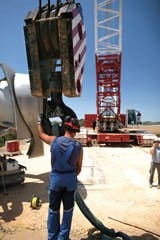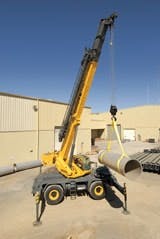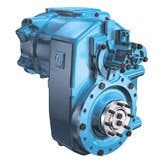Your crane is down on a critical job site with no time to lose. Twenty guys are standing around waiting for a beam to be lifted into place or a concrete wall erected, and the whole job comes to a screeching halt because the equipment isn’t working properly. You’re tempted to buy that inexpensive will-fit part from the guy down the street, just to get things up and running again. Here’s why it isn’t worth the risk.
Proper lift equipment maintenance not only prolongs machine life, but it is also the first step toward keeping workers safe on the job. There are a number of maintenance considerations specific to cranes that equipment maintenance technicians should keep in mind.
One of the simplest, yet most important, things to do is to use OEM-supplied parts. This is the only way to ensure the integrity of the replacement. These parts are inspected and quality-control tested by the OEM to exact equipment specifications designed by the manufacturer. Non-OEM parts suppliers, in most cases, are not even aware of the manufacturer’s specifications nor do they have access to review the original specifications against the design drawings.
The decision to use aftermarket parts is often driven by one of two things: availability or cost.
Availability of replacement parts is critical to the operational efficiency and uptime for any piece of equipment. When equipment requires repair, some end-users focus on the initial cost of the part. But they fail to consider the true cost of a repair and the lifetime cost of ownership.
The cost of unexpected downtime due to inferior parts or associated components not functioning per specification will increase the equipment’s total lifecycle cost. For example, if a generic part functions at 95 percent of the original part’s efficiency, has a lifespan rated at 80 percent of the OEM part, and initially costs 20 percent less, end-users could risk losing thousands of dollars due to additional downtime while also potentially spending more on fuel to operate the equipment.
Availability is another issue. Obtaining the right part quickly is a top priority for all equipment owners with a crane down in the field. Many equipment manufacturers have developed numerous systems and processes to be able to deliver faster parts and service.
An extensive dealer and distributor network is one of the first steps to being able to provide efficient, localized service. These dealers, supported by manufacturer-supported regional repair technicians, are the front line when faced with equipment down in the field. And working with them for more routine preventive maintenance can not only avoid unscheduled downtime, but can also increase the life of the crane.
Look for dealers who encourage their technicians to take advantage of manufacturer-sponsored training programs. These programs help build a better understanding of operating systems, components, maintenance, and repair of specific crane brands and models. This knowledge, applied to a downed crane, helps ensure that it will be repaired quickly and correctly, giving additional peace of mind not available when purchasing from a non-OEM approved source.
Some manufacturers, through their dealer networks, also offer 24/7 online parts ordering so parts can be ordered and shipped at any time, from any place in the world.
But the most important thing to keep in mind when you are responsible for repairing and maintaining cranes or any other type of equipment is to follow manufacturer-recommended service intervals. Service intervals and other maintenance recommendations outlined in OEM service manuals are designed to help keep equipment running at optimal levels, which helps owners and operators stay up and running and profitable with their equipment.
Remember the old saying: Maintenance doesn’t cost, it pays.
How to Maintain Hooks
- Before use, hooks must be inspected by an experienced rigger.
- Remove a hook from service if any of the following are in evidence:
a. Cracks, nicks or gouges
b. Twist exceeding 10 degrees from plane of unbent hook
c. Damage or malfunction to the latch
d. Throat opening exceeding 15 percent
e. Wear exceeding 10 percent of original dimension
f. Damage from heat
g. Unauthorized repairs - Cracks, nicks and gouges should be removed by a qualified person. Grind lengthwise, following the contour of the hook.
- If removing the damaged area results in a loss of more than 10 percent of the original dimension, the hook must be replaced.
- Never repair, alter or reshape a hook by welding, heating, burning or bending, unless approved by the hook manufacturer.
- When lifting, ensure the hook, not the latch, supports the load. The sling or lifting device must always be seated properly in the bowl of the hook.
- Never side load, back load or point load a hook. All reduce hook strength and create an unsafe condition. Point loading can reduce hook capacity as much as 60 percent.
How to Maintain Wire Rope
- Put on gloves before handling and checking the condition of your wire ropes.
- Wire ropes should be cleaned at intervals using a brush to remove hardened deposits of grease, which prevent the penetration of lubricants.
- Do not use solvents for cleaning. They may destroy the textile or synthetic components which make up the wire rope.
- The wire rope must be checked over its entire length.
- Check the level of wear and the proper functioning of the sheaves: One defective sheave in a circuit may result in premature wear to the wire rope.
- Apply grease using the product recommended by the manufacturer. The lubrication intervals must take the specific conditions of usage into account: proximity to the coast, metallurgical or chemical environment, harsh climatic conditions, etc.
- All wire ropes showing a broken strand, a collection of visible broken wires, deformation, corrosion, kinks, pleats, crushing, etc. should be scrapped.
- A worn or damaged wire rope should only be replaced with a rope recommended by the equipment manufacturer.
- When replacing the wire rope, it must be possible to brake the drum (coil) to prevent the rope from unwinding too fast or dragging when winding up.
- The length of the new wire rope should match the crane configuration and should cover all drum winding layers.
How to Maintain Mobile Crane Transmissions
- Follow fluid and filter rules set by the transmission manufacturer. Many transmission failures can be avoided with adherence to service schedules.
- Transmission fluid cools, lubricates and transmits hydraulic power. Too little fluid and the torque converter, bushings, bearings and clutches will not receive an adequate supply of oil. Too much oil can cause it to aerate, resulting in overheating.
- Oil leaks primarily occur around the side of the transmission casing, external oil cooler or where power take-off points are located. Check these points frequently.
- Try to keep a transmission free of contaminants. Solid foreign bodies have a detrimental effect on bushings and roller bearings.
- Driveshaft components, the oil cooler, and transmission filter regulator should be examined at 25,000 mile intervals.
- Check fastener tightness. Bolts with an incorrect torque can cause vibration. Stripped threads may lead to transmission removal for main case replacement.
- Check electronics and wiring harnesses as part of an inspection.
- Have crane operators report potential troubles such as odd automatics shifts, fluid leaks and unusual noises and take action to avoid downtime.
About the Author
John Bittner
John Bittner is director, global marketing, for Manitowoc Crane Care.


